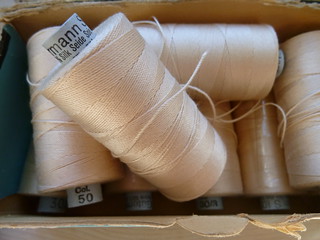 Researchers at the universities of Bristol and Cambridge in the U.K. found natural silk and cellulose fibers effective as scaffolding to rebuild damaged cartilage with stem cells. The team led by Wa’el Kafienah in Bristol’s School of Cellular and Molecular Medicine published its findings in a recent issue of the journal Biomacromolecules (paid subscription required).
Researchers at the universities of Bristol and Cambridge in the U.K. found natural silk and cellulose fibers effective as scaffolding to rebuild damaged cartilage with stem cells. The team led by Wa’el Kafienah in Bristol’s School of Cellular and Molecular Medicine published its findings in a recent issue of the journal Biomacromolecules (paid subscription required).
The research team examined the feasibility of using these natural fibers with mesenchymal stem cells to grow new skeletal tissue such as cartilage. In this case, the fibers would serve as a matrix or scaffold on which adult stem cells could bind and grow.
Mesenchymal stem cells are typically found in bone marrow, but can also be derived from umbilical cord blood. They can grow and differentiate into skeletal or connective tissue, such as cartilage. For this study, the researchers took mesenchymal stem cells from four volunteers.
Kafienah, with colleagues from Bristol’s Advanced Composites Centre, induced stem cells to grow on blends of silk and cellulose into cells known as chondrocytes, which are precursors to healthy cartilage cells. The team used ionic liquids — salts in liquid form with a low melting point — to dissolve the biopolymers in the fibers, and interact with the stem cells to generate extracellular material similar to cartilage.
The researchers tested the process with pure cellulose fibers, as well as 50/50 and 75 cellulose/25 silk blends. They found the 75/25 blend most effective in differentating the stem cells into chondrocytes.
The medical and materials researchers are now working on developing three-dimensional tissue samples for implantation with patients, as well as getting a better understanding of the interactions between the biopolymers in these fibers and stem cells that create the engineered tissue.
Read more:
- FDA OKs Trial of Biopolymer to Treat Spinal Cord Injury
- Synthetic Tissue Created with Water, Lipids, 3-D Printing
- Nano Patterns in Plastic Help Stem Cells Become Bone Cells
- Light-Activated Hydrogel, Stem Cells Recreate Knee Cartilage
- Tough, Stretchable Hydrogel Cartilage Replacement Developed
Photo: storebukkebruse/Flickr
* * *

 RSS - Posts
RSS - Posts